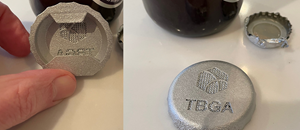Video: Where Does Additive Manufacturing Make Sense?
Can 3D printing produce a useful, functional part? The answer is, unequivocally, yes. Editors discuss where and when AM makes sense in this video.
3D printing is becoming a proven and valid manufacturing process, but is it the best tool for the job? The answer depends on both the part itself and the production constraints.
In this video, Peter Zelinski and I discuss specific scenarios in which additive manufacturing makes sense. Watch below, or read on for the transcript.
Transcript
Stephanie Hendrixson
I'm Stephanie Hendrixson, senior editor with Additive Manufacturing magazine. I'm here with Pete Zelinski.
Pete, you and I work in the additive space and there are a couple of questions that we encounter pretty frequently:
Is additive manufacturing the same as 3D printing?
Peter Zelinski
Additive manufacturing is the approach to manufacturing that has 3D printing at its heart. If I am 3D printing, I am not necessarily manufacturing, and additive manufacturing begins with 3D printing, but it includes more than that. So ultimately, these are different terms and the difference is significant.
Stephanie Hendrixson
Are 3D-printed parts as good as those made through injection molding or machining or some other type of conventional technology?
Peter Zelinski
It depends. If what you want is a near-net-shape part, 3D printing is better. It will get you nearer to net shape than casting or forging will.
I think you're asking a question that's more fundamental than that: Can 3D printing produce a useful, functional part? The answer is, unequivocally, yes. Additive manufacturing is an option that's on the table now for making a tool or making an end-use production part.
Stephanie Hendrixson
In what situations does additive make the most sense?
Peter Zelinski
The reason to use additive often has to do with realizing a geometrically intricate form that you couldn't get any other way, and then there are all these other reasons to use additive as well. So help me out—let's rattle off use cases for additive:
Consolidating an assembly. Take a component that's formerly an intricate assembly of lots of little pieces and just 3D print that as a single complex part.
Stephanie Hendrixson
Lightweighting, the ability to place the material only where you need it, to fill a solid form with a lattice structure, and not carry that extra weight.
Peter Zelinski
Conformal cooling, particularly in molds. Don't have straight drilled holes for cooling but instead grow the cooling channels internally to follow the contours of the form.
Stephanie Hendrixson
Low volumes of parts. If you only need one or 50 or 100 of something, maybe you can 3D print it instead of putting that investment into a mold.
Peter Zelinski
Making tools. A tool is often a one-off part that's got a lot of complexity in it, and commands a lot of lead time. Make that tool additively.
Stephanie Hendrixson
Customization, when you have a product that requires some level of personalization. Maybe it's a medical implant and you want to make it the exact right size for that patient.
Peter Zelinski
Topology optimization. Allow software to grow a part form digitally based on the loads that it requires so that you use only the mass and material needed.
Stephanie Hendrixson
Repair applications. If you have a part that has seen a lot of wear, you can rebuild the portion of it that’s missing.
Peter Zelinski
I think there's another way to face this question as well: The best use of additive ultimately is to realize a shape, a form that you didn't think you could make or solve a problem that you didn't know you had.
So what's the place for additive? The place for additive is at the beginning of the conversation, at the beginning of the design process.
Related Content
Understanding PEKK and PEEK for 3D Printing: The Cool Parts Show Bonus
Both materials offer properties desirable for medical implants, among other applications. In this bonus episode, hear more from Oxford Performance Materials and Curiteva about how these companies are applying PEKK and PEEK, respectively.
Read MoreCopper, New Metal Printing Processes, Upgrades Based on Software and More from Formnext 2023: AM Radio #46
Formnext 2023 showed that additive manufacturing may be maturing, but it is certainly not stagnant. In this episode, we dive into observations around technology enhancements, new processes and materials, robots, sustainability and more trends from the show.
Read MoreA Framework for Qualifying Additively Manufactured Parts
A framework developed by The Barnes Global Advisors illustrates considerations and steps for qualifying additively manufactured parts, using an example familiar to those in AM: the 3D printed bottle opener.
Read MoreVideo: What Is Electron Beam Melting (EBM)?
Electron beam melting is the higher-energy metal 3D printing process offering advantages when it comes to productivity and thermal stresses. Here is an introduction to EBM.
Read MoreRead Next
Bike Manufacturer Uses Additive Manufacturing to Create Lighter, More Complex, Customized Parts
Titanium bike frame manufacturer Hanglun Technology mixes precision casting with 3D printing to create bikes that offer increased speed and reduced turbulence during long-distance rides, offering a smoother, faster and more efficient cycling experience.
Read MoreAlquist 3D Looks Toward a Carbon-Sequestering Future with 3D Printed Infrastructure
The Colorado startup aims to reduce the carbon footprint of new buildings, homes and city infrastructure with robotic 3D printing and a specialized geopolymer material.
Read MorePostprocessing Steps and Costs for Metal 3D Printing
When your metal part is done 3D printing, you just pull it out of the machine and start using it, right? Not exactly.
Read More
.jpg;width=70;height=70;mode=crop)
















